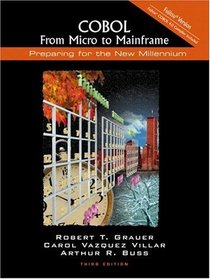Search -
COBOL: From Micro to Mainframe: Fujitsu Version (3rd Edition)
COBOL From Micro to Mainframe Fujitsu Version - 3rd Edition
Author:
Text covers all basic COBOL elements. Version 4.0 of the Fujitsu compiler, editor, and project manager. New third edition. Softcover. CD-ROM included. DLC: COBOL (Computer program language) — Preface — The Fujitsu Version of COBOL: From Micro to Mainframe, Third Edition parallels our earlier work, but has been updated to support Fujitsu COBOL Vers... more »
Author:
Text covers all basic COBOL elements. Version 4.0 of the Fujitsu compiler, editor, and project manager. New third edition. Softcover. CD-ROM included. DLC: COBOL (Computer program language) — Preface — The Fujitsu Version of COBOL: From Micro to Mainframe, Third Edition parallels our earlier work, but has been updated to support Fujitsu COBOL Vers... more »
ISBN-13: 9780130858498
ISBN-10: 0130858498
Publication Date: 12/22/1999
Pages: 908
Rating: ?
ISBN-10: 0130858498
Publication Date: 12/22/1999
Pages: 908
Rating: ?
0 stars, based on 0 rating
Genres:
- Computers & Technology >> Programming Languages >> Cobol
- Computers & Technology >> Programming Languages >> Compilers
- Computers & Technology >> Programming >> General
- Computers & Technology >> Hardware & DIY >> Mainframes & Minicomputers




